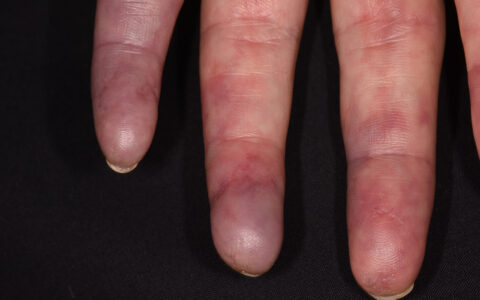Researchers at Vanderbilt University Medical Center are studying the treatment of autoimmune disorders, focused on precision medicine to offer more targeted agents for each disease and each patient.
Their goal is to supplement or replace the traditional, blunt instrument of one-size-fits-all first-line treatments, which may have severe toxic effects.
A principal method of this research is immunophenotyping: identifying specific subtypes of immune cells that can indicate the progression of disease and treatment effectiveness. By analyzing a wide range of cells, researchers can narrow the list of biomarkers to those that are most important in diagnosis and treatment.
Two such studies have been published in Frontiers in Immunology and in Cytometry Part A. Vanderbilt Division of Rheumatology and Immunology contributors include Erin Wilfong, M.D., Ph.D., Rachel Bonami, Ph.D., and Leslie Crofford, M.D., division chief.
Targeted Therapies
While mutations have proven to be valuable targets in cancer, immunophenotyping is expected to lead to precision treatments for rheumatology patients, said Wilfong. She added that these goals are still years rather than months away.
“We treat a lot of autoimmune diseases with the same medications,” Wilfong said. “Some of these drugs, such as mycophenolate mofetil, are applicable across many different rheumatic diseases – lupus, scleroderma, inflammatory myositis. It’s first-line therapy at a lot of centers.”
However, it is not targeted therapy.
“The standard frontline regimen is the same for everybody – immunosuppressants that suppress immune cells indiscriminately,” Wilfong said. “In this research, we look at the broad immunophenotypes and figure out which cell populations are dysregulated.”
Identifying the ‘Problem Children’
“One of the things our work is focused on is figuring out what, if any, changes are apparent in somebody with autoimmune disease,” said Bonami, referencing the distribution of different types of B cells that have different functions: antibody-secreting cells, memory cells, subtypes of memory cells.
“We try to develop a sense of which B cell differences may predict somebody is at risk for disease relapse or whether they are or are not responding to a therapy.”
They are on the lookout for “the problem children, the cells that matter, the cells that you would like therapies to hit,” Bonami said. “And right now, our therapies can’t hit autoantigen specific B cells without broadly knocking out many immune functions.”
“We try to develop a sense of which B cell differences may predict somebody is at risk for disease relapse.”
Examining shifts in cell populations, their autoantigen specificity, and their likelihood of being pathogenic can point the way toward effective therapies, she said.
These biomarkers flag early immune changes that show whether a treatment is working, months or even years before the disease can further damage tissue. If the drug is not working, earlier indicators allow physicians to avoid the harmful effects of long-term immunosuppressive therapy.
Elaborate Algorithms
Some of the techniques and methods in the research employ advanced and often expensive technology, including mass cytometry by time of flight (CyTOF), followed by dimensionality reduction algorithm t-distributed stochastic neighbor embedding (t-SNE) and additional machine-learning algorithms.
These elaborate methods allow analysis of large numbers of immune cells to find a few that are most relevant for future therapies or correlating a particular cell population to treatment response with a given medication. Eventually, the researchers say, these cell populations could be identified using widely available blood tests and cheaper technologies.
According to Wilfong, it is important to see people early in their disease before therapies are initiated so that researchers can start developing these algorithms.
“Automated algorithms can correlate an immune phenotype to a specific group assignment,” she said. “We can specify diseased versus healthy individuals, and the algorithms can pick out the differences, which represent abnormal immune cells.”
Additional studies with larger sample sizes will continue to investigate immune cells in healthy patients and in patients with autoimmune diseases to understand more precisely which cells have the most utility as biomarkers, as well as the functions and processes involved.






